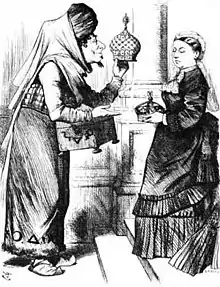.svg.png.webp) | |
| Long title | An Act to enable Her most Gracious majesty to make an addition to the Royal Style and Titles appertaining to the Imperial Crown of the United Kingdom and its Dependencies. |
|---|---|
| Citation | 39 & 40 Vict., c. 10 |
| Introduced by | Benjamin Disraeli |
| Territorial extent | Throughout the British Empire |
| Dates | |
| Royal assent | 27 April 1876 |
Status: Spent | |
| Text of statute as originally enacted | |
The Royal Titles Act 1876 (39 & 40 Vict., c. 10) was an Act of the Parliament of the United Kingdom which officially recognized Queen Victoria (and subsequent monarchs) as “Empress of India”.[2]
This title had been assumed by her in 1876, under the encouragement of the Prime Minister Benjamin Disraeli.[3] The long title of the Act is "An Act to enable Her most Gracious majesty to make an addition to the Royal Style and Titles appertaining to the Imperial Crown of the United Kingdom and its Dependencies."
References
- ↑ The citation of this Act by this short title was authorised by the Short Titles Act 1896, section 1 and the first schedule. Due to the repeal of those provisions it is now authorised by section 19(2) of the Interpretation Act 1978.
- ↑ "Victoria (r. 1837-1901)". The Royal Household. Retrieved 23 March 2015.
Victoria's popularity grew with the increasing imperial sentiment from the 1870s onwards. After the Indian Mutiny of 1857, the government of India was transferred from the East India Company to the Crown with the position of Governor General upgraded to Viceroy, and in 1877 Victoria became Empress of India under the Royal Titles Act passed by Disraeli's government.
- ↑ "History of the Monarchy, Victoria". Archived from the original on 2 February 2002.
This article is issued from Wikipedia. The text is licensed under Creative Commons - Attribution - Sharealike. Additional terms may apply for the media files.
